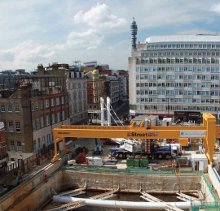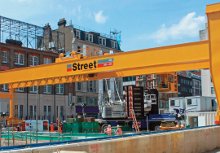Growing pains
25 October 2012Still firmly in the grip of a second recessionary dip, the UK government is taking steps to shore up British businesses. But how are lifting equipment firms managing to hold on in the meantime?
Last month the Governor of the bank of England, Mervyn King, said that he was optimistic that there have been signs of a recovery in the British economy. With the recent small upward revisions of the UK's GDP, albeit small revisions, his point did seem to have some basis.
Since then however, there have been some disappointing results from recent purchasing manager surveys for the UK. According to the Markit purchasing manager's index of manufacturing activity the country's manufacturing output -- measured as a function of 50 where any value above indicates growth and anything below 50 indicating a decline in output -- the index dropped to 49.6 on the index in August to 48.4 in September.
This followed a three-month period where the manufacturing index had rallied from a three-year low of 45.9, indicating that although a volatile but generally upward trend may being observed, a return to growth in the sector will be painfully slow.
In addition, an expected rally for construction industry output in September -- against the backdrop of a 1.9 fall in the UK Markit /CIPS Purchasing Index value for construction from 50.9 in July down to 49 in August -- has proven disappointing, strengthening to 49.5 which was significantly lower than expected.
Last month, the UK's Chartered Institute of Purchasing and Supply (CIPS) CEO David Noble commented on construction sector activity, saying, "This is dire news for the construction sector which saw its fastest drop in new orders for over three years.
"Both the decline in commercial activity and the significant drop in new orders are particularly worrying. The commercial sector had previously been propping up the figures and the lack of new contracts suggests things will get worse before they get better. Inevitably confidence has also been hit hard, and it has not been recorded as low as it is now, since last October. For good reason too, as it's clear that tough times still lie ahead."
With the current prevailing logic being that the underlying strength of the construction market is going to remain poor throughout the rest of 2012 due to falling new orders, battening down the hatches and doubling down to make the most of projects already underway in the UK may be the only gameplan.
While the construction sector as a whole is not performing particularly well, large-scale projects like Crossrail are providing a significant support base for the UK economy.
Industrial crane and hoist manufacturer Street Crane has been involved with this project for some time, and now has ten cranes installed across different Crossrail sites, supporting construction work as the project continues.
Expected to be fully operational before 2020, the completed Crossrail line will run from Maidenhead to the west of London to Shenfield and Abbey Wood in the east, requiring around 118km of tunnelling of which 21km is in twin bore.
To support this tunnelling work the company provided six 10t single girder cranes for tunnel segment casting shops working for the project. These cranes are being used to remove newly cast tunnel segments from their moulds as well as during transportation of the cast segments from the casting shop to the tunnel boring machines. Street Crane also have three rail running Goliath cranes installed at Crossrail tunnel segment curing yards, which have been designed to be fully-weatherproof. These are being used for placement of the tunnel segments and their retrieval once they have matured to full strength.
The project planners for Crossrail boast that as much as 90% of the total project investment is directed to UK companies, and Street Crane are doubtless happy to make up some of that number.
However, not content with the nine cranes already working on the Crossrail project they have recently provided a 40t double girder Goliath crane to work at the Crossrail site located on the world-renowned shopping destination Oxford Street. The crane has now been in service there for three months lifting spoil skips and lowering tunnel segments along with other pre-cast elements for the Crossrail tunnel and new Tottenham Court Road Western Ticket Hall.
For this particular job, Street Crane decided on a double girder box beam design with twin custom built TVX hoists, with an operator cab on the crane bridge. Each of these hoists is capable of lifting 20t independently, and Street Crane says that they lend a great deal of flexibility to the Goliath crane as they can be used singly or in tandem, depending on the weight and geometry of the load to be moved. To set this crane up on the site large ground beams, each of them 1.5m in height, needed to be cast alongside the construction pit at 31m apart for the crane legs to run along. As well as providing a barrier between topside operations and work going on in the construction pit, these ground beams also raise the crane up from ground level to provide a buffer from any ground disturbance as a result of excavation works, guarding against interruption of crane operations.
Despite being raised, the crane can lift out from the pit up to a maximum height of 37m at speeds between 1.5m/min and 15m/min in standard mode. However its maximum hoisting speed can be boosted up to 23m/min for lighter loads weighing 2t or less. In addition to spanning the pit, the bridge of Street Crane's Goliath also cantilevers by 5.1m at on side so that spoil skips can be offloaded onto trucks positioned outside the protected excavation area. The rectangular legs of the Goliath crane on this side were specially designed to ensure that skips loaded with construction waste would easily be able to pass between them for offloading. However there is only one Crossrail, and for any company to rely on this alone would be more than folly. For Street Crane, work from UK customers currently only accounts for around USD 12.1M (GBP7.5M) of its total turnover, roughly 30 per cent.
As with many European countries, the poor economic outlook in the UK means that any business to survive recessionary pressures booming economies elsewhere in the world must be looked to with greater interest. The lion's share of Street Crane's profit comes from crane component sales, hoists, controls etc, that can be sold as crane kits to be assembled by the end-user at its destination.
While lifting equipment designed to UK and European standards is in great demand all over the world, not every company has the network overseas or the resources to develop one.
However Street Crane learned in July that the UK government was well aware that addressing this concern this could help boost the prospects of small and medium sized businesses in the UK looking to leverage international demand.
Touting Street Crane as an exemplar company during a visit to the firm's Derbyshire factory in High Peak, the UK government's chancellor of the exchequer, George Osborne, revealed a new plan to make more low cost loans available to UK businesses for just this kind of entrepreneurialism.
Known as the Funding For Lending programme, the chancellor said that by providing low interest funding for moneylenders from the bank of England, these financial institutions could use the facility to provide lower cost loans directly to UK businesses.
He went further, making it clear the recipient banks can only be eligible for this funding on the condition that the funds are used to make lower cost loans directly to UK businesses and families. He said: "The end result is a firm like this will see a cheaper loan so it can expand and take people on."
The move, in response to frequently voiced concerns in the UK that a lack of willingness to lend from the banks is helping to stunt growth in many sectors, has already seen 13 banks and building societies in the UK sign up for the scheme, and the government says it has already seen signs that credit availability is improving. Street Crane chairman Martin Street said: "Many UK engineering businesses are finding it difficult to raise funds for capital investment in equipment. Let's hope that this scheme makes it easier for these companies to invest in new cranes and we can then see a revival of the fortunes of our UK crane sales and the manufacturing sector generally."
Low levels of product demand along with raised raw material costs certainly has made life difficult for manufacturers in the UK. Companies need to take their opportunities where they find them, even larger crane companies that generate business across a wide swathe of the globe cannot afford to simply take a hit in the UK and wait it out.
However with companies like J&D Pierce, a Scottish contracting firm specialising in structural steelwork, keen to be able to take advantage of opportunities now more than ever Konecranes UK is keeping itself busy.
Even with construction floundering, the company is spending in the region of USD 161,800 (GBP 100,000) refitting one of its factories in Glengarnock, Ayrshire with six new cranes to handle structural steel in its production area.
The East Kilbride Konecranes facility is installing the six cranes, which include a 10t CXTS single girder crane along with five smaller 5t single girder CXTS cranes. Three of each of these cranes will be divide between two fabrication bays, with the cranes required to span an area of 17.3m to properly serve the facility. Konecranes UK is keeping itself busy.
Even with construction floundering, the company is spending in the region of USD 161,800 (GBP 100,000) refitting one of its factories in Glengarnock, Ayrshire with six new cranes to handle structural steel in its production area. The East Kilbride Konecranes facility is installing the six cranes, which include a 10t CXTS single girder crane along with five smaller 5t single girder CXTS cranes. Three of each of these cranes will be divide between two fabrication bays, with the cranes required to span an area of 17.3m to properly serve the facility.
One of the features included on the cranes is thermal protection to ensure the high temperatures in the workshops from heat given off during welding does not affect the cranes' performance. This is in addition to a host of features such as inverter controlled variable speeds for cross and long travel motions, dual speed hoists, and festooned cross travel conductors in each bay.
Another more unique opportunity in the UK is being provided elsewhere in Scotland. A call for tenders has been issued by the Dounreay nuclear complex in Caithness for robotic crane that will be used to remove radioactive material from a waste pit. Decommisioning of the Dounreay site requires the removal of tonnes of waste from a huge pit on site, roughly 65.4m in depth, and due to the nature of the radioactive waste tenders are being sought from crane builders to provide the equipment to complete the work. Tenders are being sought for two contracts to design, build and install the robotic apparatus. The work for Dounreay Site Restoration Limited (DSRL) is worth a total of about USD 6.3M (GBP 4M).
The remote-controlled machine will reach down into the pit as work to clean inside the shaft is accelerated. The robotic crane and grabber will need to be designed to cope with a challenging environment. Dounreay expects work on this project to take up until roughly 2025 to complete.
Although the government may be keen to put measures in place to get the economy going again, Bank of England policymakers have decided to hold off on announcing another round of quantitative easing, as had been anticipated. Commentators speculate that this still could still happen as early as November since the British Pound has remained fairly strong in the face of recent events.
However it has slipped slightly against the Euro, leading some to speculate the USD 605bn (GBP 375bn) Monetary Policy Committee funds earmarked for further economy boosting will remain unused. This has provided mixed signs to the business world, and many will be playing a game of wait-and-see in the hopes of the market managing to help right an economy in so much turmoil.



